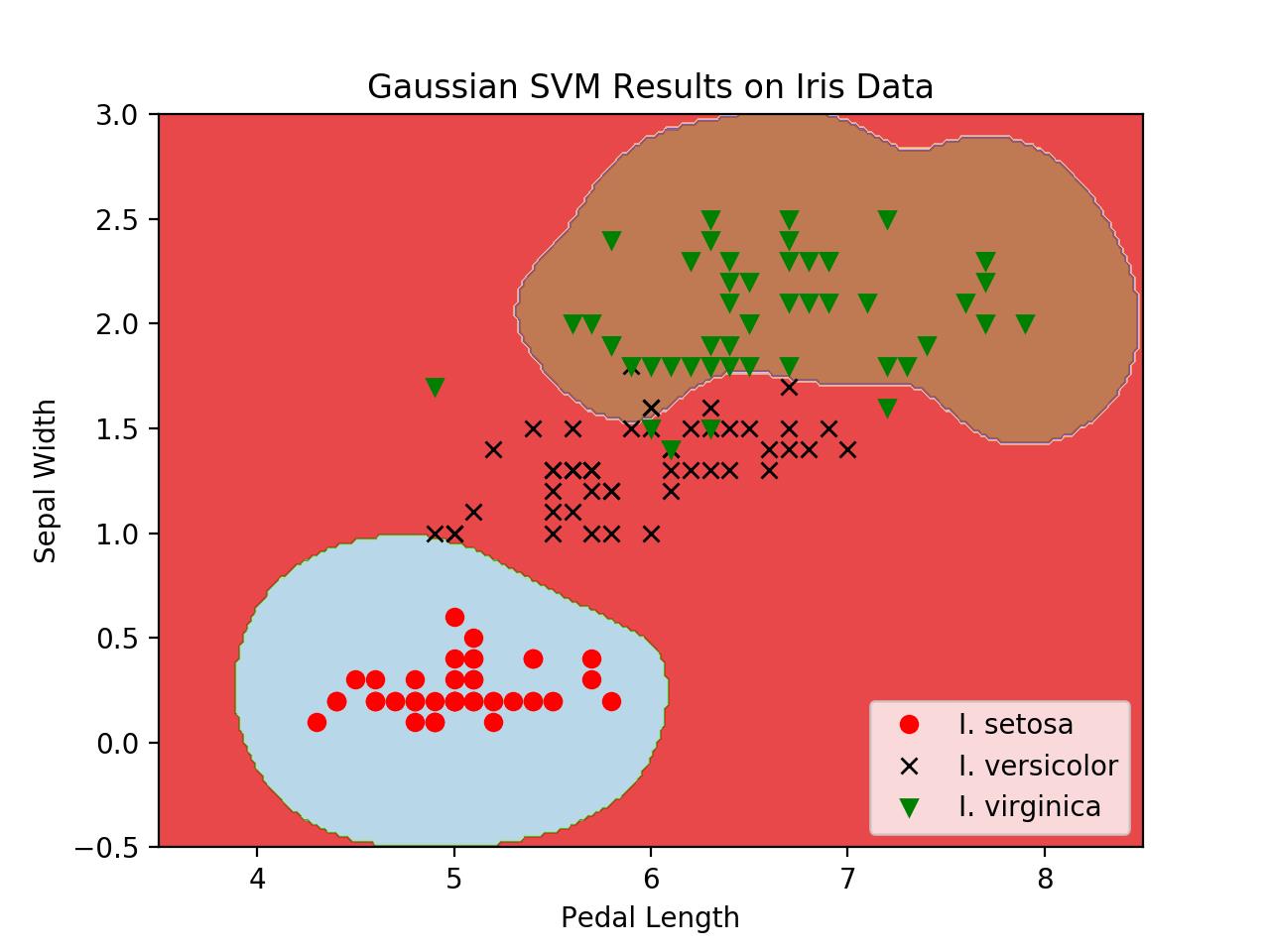tensorflow实现svm多分类 iris 3分类——本质上在使用梯度下降法求解线性回归(loss是定制的而已)
Posted 将者,智、信、仁、勇、严也。
tags:
篇首语:本文由小常识网(cha138.com)小编为大家整理,主要介绍了tensorflow实现svm多分类 iris 3分类——本质上在使用梯度下降法求解线性回归(loss是定制的而已)相关的知识,希望对你有一定的参考价值。
# Multi-class (Nonlinear) SVM Example
#
# This function wll illustrate how to
# implement the gaussian kernel with
# multiple classes on the iris dataset.
#
# Gaussian Kernel:
# K(x1, x2) = exp(-gamma * abs(x1 - x2)^2)
#
# X : (Sepal Length, Petal Width)
# Y: (I. setosa, I. virginica, I. versicolor) (3 classes)
#
# Basic idea: introduce an extra dimension to do
# one vs all classification.
#
# The prediction of a point will be the category with
# the largest margin or distance to boundary.
import matplotlib.pyplot as plt
import numpy as np
import tensorflow as tf
from sklearn import datasets
from tensorflow.python.framework import ops
ops.reset_default_graph()
# Create graph
sess = tf.Session()
# Load the data
# iris.data = [(Sepal Length, Sepal Width, Petal Length, Petal Width)]
iris = datasets.load_iris()
x_vals = np.array([[x[0], x[3]] for x in iris.data])
y_vals1 = np.array([1 if y == 0 else -1 for y in iris.target])
y_vals2 = np.array([1 if y == 1 else -1 for y in iris.target])
y_vals3 = np.array([1 if y == 2 else -1 for y in iris.target])
y_vals = np.array([y_vals1, y_vals2, y_vals3])
class1_x = [x[0] for i, x in enumerate(x_vals) if iris.target[i] == 0]
class1_y = [x[1] for i, x in enumerate(x_vals) if iris.target[i] == 0]
class2_x = [x[0] for i, x in enumerate(x_vals) if iris.target[i] == 1]
class2_y = [x[1] for i, x in enumerate(x_vals) if iris.target[i] == 1]
class3_x = [x[0] for i, x in enumerate(x_vals) if iris.target[i] == 2]
class3_y = [x[1] for i, x in enumerate(x_vals) if iris.target[i] == 2]
# Declare batch size
batch_size = 50
# Initialize placeholders
x_data = tf.placeholder(shape=[None, 2], dtype=tf.float32)
y_target = tf.placeholder(shape=[3, None], dtype=tf.float32)
prediction_grid = tf.placeholder(shape=[None, 2], dtype=tf.float32)
# Create variables for svm
b = tf.Variable(tf.random_normal(shape=[3, batch_size]))
# Gaussian (RBF) kernel
gamma = tf.constant(-10.0)
dist = tf.reduce_sum(tf.square(x_data), 1)
dist = tf.reshape(dist, [-1, 1])
sq_dists = tf.multiply(2., tf.matmul(x_data, tf.transpose(x_data)))
my_kernel = tf.exp(tf.multiply(gamma, tf.abs(sq_dists)))
# Declare function to do reshape/batch multiplication
def reshape_matmul(mat, _size):
v1 = tf.expand_dims(mat, 1)
v2 = tf.reshape(v1, [3, _size, 1])
return tf.matmul(v2, v1)
# Compute SVM Model
first_term = tf.reduce_sum(b)
b_vec_cross = tf.matmul(tf.transpose(b), b)
y_target_cross = reshape_matmul(y_target, batch_size)
second_term = tf.reduce_sum(tf.multiply(my_kernel, tf.multiply(b_vec_cross, y_target_cross)), [1, 2])
loss = tf.reduce_sum(tf.negative(tf.subtract(first_term, second_term)))
# Gaussian (RBF) prediction kernel
rA = tf.reshape(tf.reduce_sum(tf.square(x_data), 1), [-1, 1])
rB = tf.reshape(tf.reduce_sum(tf.square(prediction_grid), 1), [-1, 1])
pred_sq_dist = tf.add(tf.subtract(rA, tf.multiply(2., tf.matmul(x_data, tf.transpose(prediction_grid)))), tf.transpose(rB))
pred_kernel = tf.exp(tf.multiply(gamma, tf.abs(pred_sq_dist)))
prediction_output = tf.matmul(tf.multiply(y_target, b), pred_kernel)
prediction = tf.argmax(prediction_output - tf.expand_dims(tf.reduce_mean(prediction_output, 1), 1), 0)
accuracy = tf.reduce_mean(tf.cast(tf.equal(prediction, tf.argmax(y_target, 0)), tf.float32))
# Declare optimizer
my_opt = tf.train.GradientDescentOptimizer(0.01)
train_step = my_opt.minimize(loss)
# Initialize variables
init = tf.global_variables_initializer()
sess.run(init)
# Training loop
loss_vec = []
batch_accuracy = []
for i in range(100):
rand_index = np.random.choice(len(x_vals), size=batch_size)
rand_x = x_vals[rand_index]
rand_y = y_vals[:, rand_index]
sess.run(train_step, feed_dict={x_data: rand_x, y_target: rand_y})
temp_loss = sess.run(loss, feed_dict={x_data: rand_x, y_target: rand_y})
loss_vec.append(temp_loss)
acc_temp = sess.run(accuracy, feed_dict={x_data: rand_x,
y_target: rand_y,
prediction_grid: rand_x})
batch_accuracy.append(acc_temp)
if (i + 1) % 25 == 0:
print(\'Step #\' + str(i+1))
print(\'Loss = \' + str(temp_loss))
# Create a mesh to plot points in
x_min, x_max = x_vals[:, 0].min() - 1, x_vals[:, 0].max() + 1
y_min, y_max = x_vals[:, 1].min() - 1, x_vals[:, 1].max() + 1
xx, yy = np.meshgrid(np.arange(x_min, x_max, 0.02),
np.arange(y_min, y_max, 0.02))
grid_points = np.c_[xx.ravel(), yy.ravel()]
grid_predictions = sess.run(prediction, feed_dict={x_data: rand_x,
y_target: rand_y,
prediction_grid: grid_points})
grid_predictions = grid_predictions.reshape(xx.shape)
# Plot points and grid
plt.contourf(xx, yy, grid_predictions, cmap=plt.cm.Paired, alpha=0.8)
plt.plot(class1_x, class1_y, \'ro\', label=\'I. setosa\')
plt.plot(class2_x, class2_y, \'kx\', label=\'I. versicolor\')
plt.plot(class3_x, class3_y, \'gv\', label=\'I. virginica\')
plt.title(\'Gaussian SVM Results on Iris Data\')
plt.xlabel(\'Pedal Length\')
plt.ylabel(\'Sepal Width\')
plt.legend(loc=\'lower right\')
plt.ylim([-0.5, 3.0])
plt.xlim([3.5, 8.5])
plt.show()
# Plot batch accuracy
plt.plot(batch_accuracy, \'k-\', label=\'Accuracy\')
plt.title(\'Batch Accuracy\')
plt.xlabel(\'Generation\')
plt.ylabel(\'Accuracy\')
plt.legend(loc=\'lower right\')
plt.show()
# Plot loss over time
plt.plot(loss_vec, \'k-\')
plt.title(\'Loss per Generation\')
plt.xlabel(\'Generation\')
plt.ylabel(\'Loss\')
plt.show()
# Evaluations on new/unseen data

以上是关于tensorflow实现svm多分类 iris 3分类——本质上在使用梯度下降法求解线性回归(loss是定制的而已)的主要内容,如果未能解决你的问题,请参考以下文章